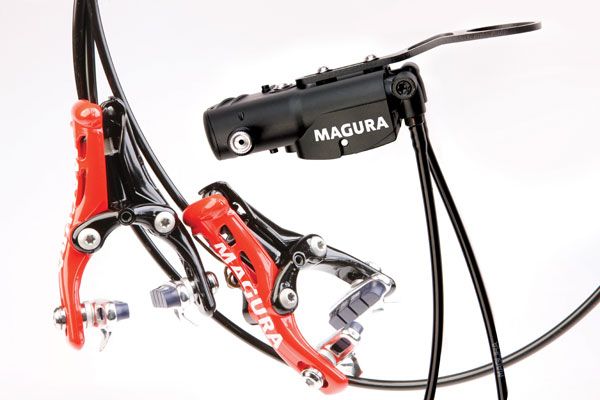Magura RT8C Hydraulic brakes

While hydraulic braking for road bikes is the new plaything for many brands, it has in fact been serious business for Magura for much longer.
It's worth noting here that we're talking about hydraulic rim braking, which Magura has been involved with since 1987, with its Hydrostop brakes and then the 1997 infamous fluoro John Tomac signature HS33 brakes.
It's this experience that Cervélo tapped into for the 2011 P5. It wanted to run internal cabling, but knew the sinuous route meant traditional cables would give poor braking performance.
Knowing fluid would be happier taking tight turns, Cervélo asked Magura to create an aero road brake. With just the need for brake lever and caliper, it didn't take long for Magura to deliver the RT8TT (time trial brake).
It was this success that led to the RT8C development. Using exactly the same magnesium caliper, alloy pivot pins and low pressure hosing as the RT8TT, a conversion box was developed. Constructed using Carbontecture, Magura's own proprietary injection-moulded, short-strand carbon-fibre composite, the box is mounted on to the fork steerer and sits below the stem.
Converting cables to fluid enables hydraulic braking to be compatible with any brand of road levers.
Not only does the end result mean that you can run the hosing in more direct routes to calipers without compromising brakes; it's also lighter. It's claimed that a metre of cable and cable outer weighs in at 85g, compared to 5g for hosing and fluid.

But for lightness and improved performance, there is a penalty; namely, price. At £369, it doesn't come cheap, especially when compared to, say, a set of standard Shimano Ultegra calipers at £105 for a pair. It certainly is a considered purchase, but with other hydraulic options still finding their feet, sometimes experience pays.
How it works
After the brake cables have been fitted - as per
usual, through the hoods - they are threaded into small arms in the
unit and terminated. Once the brakes have been bled with mineral oil, a
pull of a front or rear brake lever moves a corresponding arm inside the
unit, acting as a cylinder, pumping oil in the hosing down to the brake
calipers. This in turn enables a triangle-shaped wedge to be lifted
between two rollers, squeezing the calipers shut.
Contact www.zyro.co.uk
This article was first published in the December 5 issue of Cycling Weekly. Read Cycling Weekly magazine on the day of release where ever you are in the world International digital edition, UK digital edition. And if you like us, rate us!

Thank you for reading 20 articles this month* Join now for unlimited access
Enjoy your first month for just £1 / $1 / €1
*Read 5 free articles per month without a subscription

Join now for unlimited access
Try first month for just £1 / $1 / €1
Get The Leadout Newsletter
The latest race content, interviews, features, reviews and expert buying guides, direct to your inbox!
Founded in 1891, Cycling Weekly and its team of expert journalists brings cyclists in-depth reviews, extensive coverage of both professional and domestic racing, as well as fitness advice and 'brew a cuppa and put your feet up' features. Cycling Weekly serves its audience across a range of platforms, from good old-fashioned print to online journalism, and video.
-
 Elisa Longo Borghini emerges as Flanders favourite with Dwars door Vlaanderen victory
Elisa Longo Borghini emerges as Flanders favourite with Dwars door Vlaanderen victoryThe Italian rider soloed to her 50th career win ahead of an elite pack of chasers
By James Shrubsall Published
-
 'We did a beautiful race up until 10km to go' - Visma-Lease a Bike pull defeat from the jaws of victory at Dwars door Vlaanderen
'We did a beautiful race up until 10km to go' - Visma-Lease a Bike pull defeat from the jaws of victory at Dwars door VlaanderenWith such a difficult second place on Wednesday, could this performance affect confidence ahead of the Tour of Flanders?
By Adam Becket Published